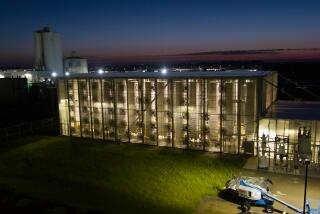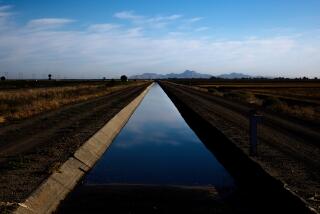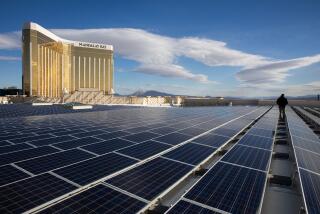For Better Solar Power, Just Add a Pinch of Salt
- Share via
When Solar Two, the large pilot solar power plant in the Mojave Desert, was dedicated last week, it differed in a crucial respect from its predecessor, Solar One, which operated from 1982 to 1986. Instead of using concentrated sunlight to heat water, it uses molten salt.
Solar Two, which produces enough power to supply 10,000 homes, operates by using large, sun-tracking mirrors to concentrate sunlight on a receiver that sits atop a tower. The concentrated sunlight heats the molten salt as it flows through the receiver.
The salt is then piped away, stored and used when needed to produce steam. The steam drives a turbine/generator that produces electricity. The system is capable of operating through intermittent clouds and can continue generating electricity long into the night. Solar One, by contrast, suffered from low efficiencies in energy storage, and passing clouds often interrupted operations.
Sandia National Laboratories played a key role in Solar Two by transferring the molten salt technology to the project. The $48.5-million cost of the project is being shared by the Energy Department and a consortium of companies that includes Southern California Edison, the Los Angeles Department of Water and Power, Arizona Public Service, Bechtel Corp. and the Electric Power Research Institute.
Skin-Deep: To minimize scarring when a severe burn heals, doctors use grafts of skin from other parts of the patient’s body. The graft is needed because the matrix that provides the base for a new layer of dermis (the sensitive inner layer of the skin) does not regenerate when damaged. Now Ioannis Yannas, a professor of polymer science and engineering at the Massachusetts Institute of Technology, has found something better: artificial skin made from collagen taken from animal tendons and glycosaminoglycan (GAG) molecules from animal cartilage.
This collagen-GAG material has pores that permit cells to grow through the scaffold it provides, making a new dermis as the material is broken down by enzymes. The epidermis, or outer skin layer, then grows over the area or is grafted on. It is much easier to graft this layer than the dermis because the dermis is one-tenth as thick and is constantly being shed and regrown.
Yannas has also had success with using a different collagen-GAG matrix to bridge severed nerve segments in the limbs of animals.
Engineering for Natural Gas: To reduce air pollution, automotive fleets have started converting van or truck engines to use clean-burning alternative fuels such as compressed natural gas and propane.
Typically, a gasoline vehicle is converted with an after-market conversion kit, or a new vehicle can be ordered factory-equipped with an after-market fuel system. Now Los Angeles-based Bonded Motors, one of the nation’s largest remanufacturers of car and light-truck engines, has come up with a natural gas drop-in replacement for existing engines that is optimized for either natural gas or propane.
Most of the engines that have been converted to burn these fuels are dual-fuel engines, designed to burn either natural gas or regular gasoline. But Bonded Motors’ Powermaker 350 is optimized for natural gas. Because natural gas and propane have octane ratings of 130 (compared with 92 for premium gasoline), engines designed for this fuel can have higher compression ratios.
The Powermaker 350--a remanufactured Chevrolet 350-cubic-inch V-8, the mainstay of light- and medium-duty Chevy and GMC trucks--also has special pistons, cylinder heads, valves, gaskets and camshaft that have been enhanced to withstand the higher pressures and temperatures of a dedicated natural gas engine.
Kathleen Wiegner, a freelance writer specializing in science and technology, can be reached via e-mail at kkwrite@aol.com
More to Read
Inside the business of entertainment
The Wide Shot brings you news, analysis and insights on everything from streaming wars to production — and what it all means for the future.
You may occasionally receive promotional content from the Los Angeles Times.










